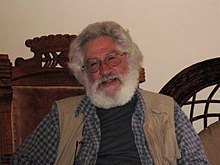Ralph Abraham (mathematician)
Ralph Abraham | |
|---|---|
 Photo by Joan Halifax | |
| Born | Ralph Herman Abraham July 4, 1936 |
| Nationality | American |
| Alma mater | University of Michigan |
| Scientific career | |
| Fields | Mathematics |
| Institutions | University of California, Santa Cruz |
| Thesis | Discontinuities in General Relativity (1960) |
| Doctoral advisor | |
Ralph Herman Abraham (born July 4, 1936) is an American mathematician. He has been a member of the faculty of the University of California, Santa Cruz (where he is currently professor emeritus of mathematics) since 1968.
Life and work[]
Abraham earned his B.S.E. (1956), M.S. (1958) and Ph.D. (1960) from the University of Michigan. Prior to joining Santa Cruz, he held positions at the University of California, Berkeley (research lecturer in mathematics; 1960-1962), Columbia University (postdoctoral fellow and assistant professor of mathematics; 1962-1964) and Princeton University (assistant professor of mathematics; 1964-1968). He has also held visiting positions in Amsterdam, Paris, Warwick, Barcelona, Basel, and Florence.
He founded the Visual Math Institute[1] at Santa Cruz in 1975; at that time, it was called the "Visual Mathematics Project". He is editor of World Futures and for the International Journal of Bifurcations and Chaos. Abraham is a member of cultural historian William Irwin Thompson's Lindisfarne Association.
Abraham has been involved in the development of dynamical systems theory since the 1960s and 1970s. He has been a consultant on chaos theory and its applications in numerous fields, such as medical physiology, ecology, mathematical economics, psychotherapy, etc.[2]
Another interest of Abraham's concerns alternative ways of expressing mathematics, for example visually or aurally. He has staged performances in which mathematics, visual arts and music are combined into one presentation.
Abraham developed an interest in "Hip" activities in Santa Cruz in the 1960s and has a website gathering information on the topic.[3] He credits his use of the psychedelic drug DMT for "swerv[ing his] career toward a search for the connections between mathematics and the experience of the Logos".[4]
Works[]
- Publications
- 1978. Foundations of Mechanics, 2nd edn. With Jerrold E. Marsden;[5] 1st edition 1967.
- 1982. Manifolds, Tensor Analysis, and Applications, 2nd edn. With Jerrold E. Marsden and Tudor Ratiu.
- 1992. Dynamics, the Geometry of Behavior, 2nd edn. With C. D. Shaw.
- 1992. Trialogues on the Edge of the West. With Terence McKenna and Rupert Sheldrake),
- 1992. Chaos, Gaia, Eros.
- 1995. The Web Empowerment Book. With Frank Jas and Will Russell.
- 1995. Chaos in Discrete Dynamical Systems. With Laura Gardini and Christian Mira.[6]
- 1997. The Evolutionary Mind. With Terence McKenna and Rupert Sheldrake.
- 2000. The Chaos Avant-garde. With Yoshisuke Ueda.
- Film
- 1989. The Strange New Science of Chaos, as himself
- 2009. Cognition Factor 2009[permanent dead link], as himself
- 2010. DMT: The Spirit Molecule, as himself[7]
References[]
- ^ Visual Math Institute website, Vismath.org, retrieved 2012-12-25
- ^ Complexity, Democracy and Sustainability The 50th Anniversary Meeting of The International Society for the Systems Sciences. Sonoma State University, 2006. Retrieved 7 June 2008.
- ^ "S Cruz 1960s". www.ralph-abraham.org.
- ^ Sheldrake, Rupert; McKenna, Terence; Abraham, Ralph (2013-08-20). The Evolutionary Mind: Conversations on Science, Imagination & Spirit. Monkfish Book Publishing. pp. 63–. ISBN 9781939681102. Retrieved 12 April 2014.
- ^ Sternberg, Shlomo (1980). "Review: Foundations of mechanics, 2nd edition, revised and enlarged, by Ralph Abraham and Jerrold E. Marsden" (PDF). Bulletin of the American Mathematical Society. New Series. 2 (2): 378–387. doi:10.1090/S0273-0979-1980-14771-0.
- ^ companion CD-ROM by Ronald Joe Record and Ralph Abraham
- ^ "Full cast and crew", DMT: The Spirit Molecule, IMDb, 2010
External links[]
- Personal website Ralph Abraham.
- Ralph Abraham at the Mathematics Genealogy Project
- Cognition Factor – 2009 film participant.
- 1936 births
- 20th-century American mathematicians
- 21st-century American mathematicians
- Columbia University faculty
- Complex systems scientists
- Living people
- Chaos theorists
- People from Burlington, Vermont
- Psychedelic drug advocates
- University of California, Berkeley College of Letters and Science faculty
- University of California, Santa Cruz faculty
- University of Michigan College of Engineering alumni
- Mathematicians from Vermont